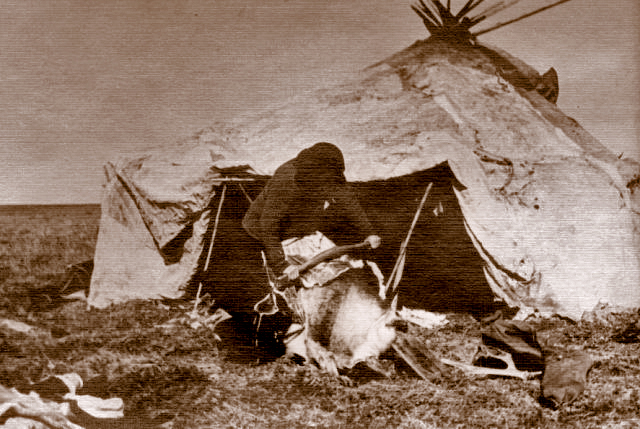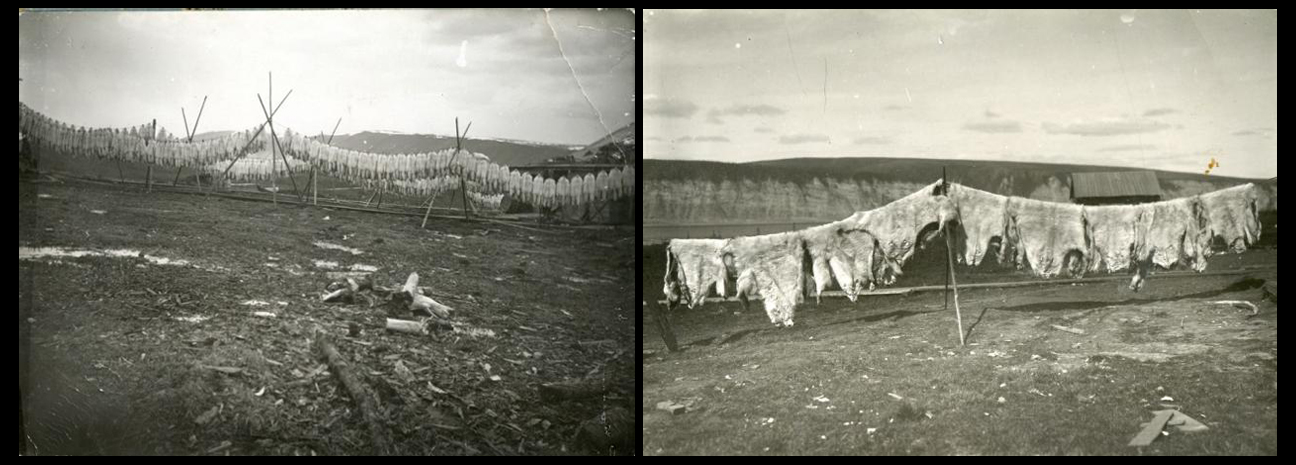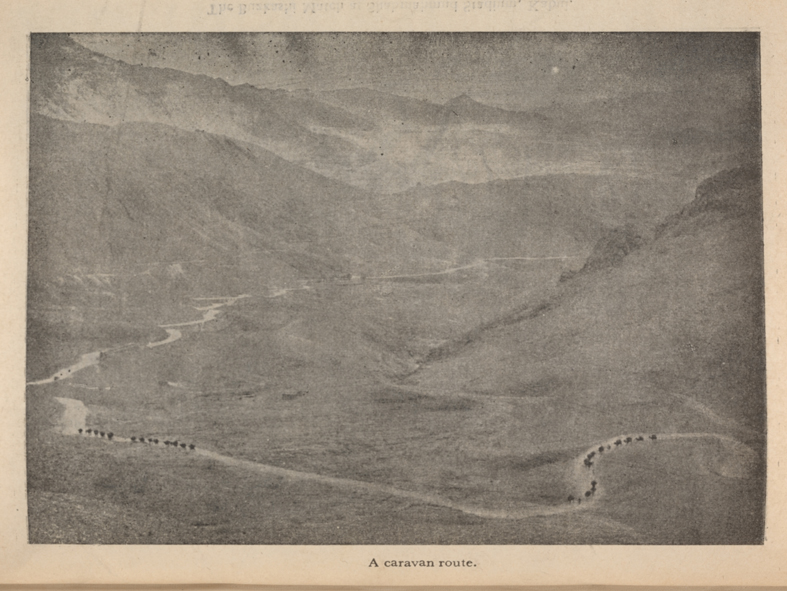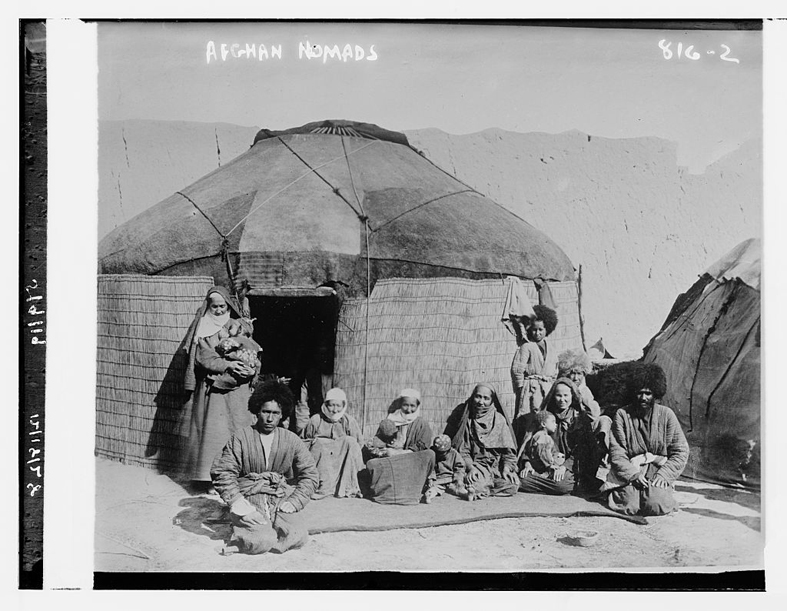YAKUT PIECED SKIN PRIMITIVE RUG
Robert Cobcroft
YAKUT PIECED SKIN PRIMITIVE RUG
This Yakut fishing scene could have been recorded in the bronze or early iron age.
The pieced skin rug on the floor of the Yakut fisherman's conical tent1 is identical in concept to the primitive pieced skin rugs stitched together by nomads in Central Asia. The rug is probably made from deer skins or reindeer, the fisherman's jacket is also fashioned from softened and stitched animal hides. Sergei Rudenko published an image of a "piece of fur clothing" in Frozen tombs of Siberia The Pazyryk Burials of Iron-Age Horsemen which closely resembles the fisherman's rug and jacket, linking these items and Central Asian pieced skin rugs to the Scythian horsemen.2 Apart from the buildings in the background this scene could have been recorded in the bronze or early iron age.
Pieced skin rugs and animal hide products including methods of softening hides are shared by Kirghiz and Yakut. The significance of the continuation of the practice of making pieced skin rugs can be linked back to a time prior to the Yakut moving North into Eastern Siberia and probably pre-dating the early Iron-Age. Kirghiz women in the Wakhan corridor of Afghanistan soften the hides3 of Karakol sheep and Yak in preparation for dip dying and stitching pieced skin rugs . Yakut women use similar methods to soften hides, here we see a Yakut women softening the hide of a deer after it's been stripped of it's flesh and dried. The hide is simply softened by applying pressure with the repeated use of a stick over it's surface.
Yakut or Sakha language is firmly rooted in their early history on the steppes further South. Migrating from Olkhon and the region of lake Baikal Northwards to Eastern Siberia. Eventually mixing with Tungusic Evens and Evenki.4 Turkic speaking Yakut have assimilated many other words into their language yet retain their Turkic identity through language and other practices. The practice of reciting epics like the Yakut Olonko is identical to the Kyrgyz of Kyrgyzstan's proud tradition of the recital of the Epic Manas. Yakut are described as pastoralists like the Kirghiz of Central Asia and the Iron-Age Scythians. Kumys5 is a favourite among Yakut at festivals, not unlike Kirghiz of Central Asia who use the same word to describe a type of fermented mares milk.
The image on the right shows a Yakut woman standing on a Yakut pieced skin primitive rug with a display of items used in conjunction with the making and serving of Kumys. She is also wearing traditional tailored animal skin clothing.
Relatively primitive pastoralism.
Nomads and pastoralists have been busily slaughtering animals wild or domestic throughout the ages, making their hides into assorted clothing, bedding, rugs, mats, trappings, shelters, boats, window covers plus many other items. Take a look at the typical inventory of the Scythian animal herd about 2,500 years ago including yaks, horse, large horned cattle, small horned animals, goats and sheep with "slight fat-tails". Scythians hunted wild animals, however this was secondary to their form of "primitive pastoralism". Deer, maral, elk, mountain goats and rams, boars, saiga, antelope, steppe cat, squirrel, sable, otter, ermine, leopard, wolf, roebuck, hare and other ungulates were all unearthed from the icy Pazyryk barrows.6
Scythian horsemen kept sheep with "slight fat-tails" which took second place in Scythian economy after horses.7 "Primitive pastoralism" practiced by the Scythians , the inclusion of yak and sheep in their herds, the secondary place that hunting took, mirrors the lifestyle of modern day Kirghiz of the Afghan Pamirs. Yakut not only produce similar animal skin items as the Kirghiz and Scythians, they are pastoralists especially known for breeding horses. A special breed of Yakut horse which can withstand sub zero temperatures sets the Yakut apart from the Evenki and other local ethnic groups.
Yakut Horsemen and Yakut Horses
Historically Yakut share similar ancient burial rituals to the Iron Age Scythian horsemen. Yakut horsemen probably settled in the region around the Lena River of the vast Sakha Republic in Eastern Siberia around the time Iron Age Scythian Horsemen were busy digging out their icy barrows in the Altai mountains. The famed Iron-Age Pazyryk rug, retrieved from the ice and mud by Sergei Rudenko dates from that period.8 Yakut burial rituals are similar to those of the Scythians, R.Bravina in a paper for the Arctic Museum discussed recent developments in the study of ancient Yakut burials.
"Some elements of the ritual of burying humans with horses, that is, position of the corpses, number of horses, in-burial installations, orientation to the West etc, show the ancient character of these elements, that were characteristic of the early nomads of Southern Siberia and Central Asia, beginning in the Bronze and early Iron Ages. It seems that horse breeding tribes settled the territory of Yakutia starting in early Iron Age."9
Rugs, trappings, bags, cradles and pack covers for sleds were crafted from animal skins by the Yakut and neighbouring Evenki, Eveni and Tungus. Window covers are even fashioned from fish skins by the Evenki. Animal hides used in making pieced skin trappings, rugs and clothing include, reindeer, deer, bear, seal and fish. Also hunted were polar bears and the polar fox.
Conical tents were used by Paleolithic Siberian hunters and favoured by Tungus, Yakut, Evenki and Eveni. Animal skins or birch bark were favoured materials for tent coverings, the Yakut fisherman's small conical tent is covered with straw. Fishing techniques were probably borrowed from neighboring taiga.10
A favourite animal.
As floor coverings animal skins are not as durable as woven items. Creating intricate patterns is more difficult with animal skins. Clipping the fur of a hide low would produce an ugly result. Size of a finished pieced skin rug including the various small pieces of sewn hide is limited, sometimes many small pieces need to be sewn to larger pieces to create a symmetrical rug.
Rudenko unearthed woven rugs which mimic animal skins, they look almost identical to modern Julkhyrs or Tulu. Woolen cloth with looped pile was unearthed from barrow 2.11 The cloth looks like any looped pile rug woven by nomadic pastoralists today. Primitive pastoralists had the option to begin weaving their rugs into patterns and shapes which afforded them flexibility in creating custom made items. Floor coverings could still provide warmth and be made to look like a favourite animal. Wool could be dyed and woven into a durable foundation. Size was no restriction and the old way of simply stitching hides together could now be used to stitch long lengths of woven items together. The pile could be clipped low yet still producing an aesthetically pleasing and durable floor covering.
Many varied uses of animal skin items afforded nomads and pastoralists with warmth, shelter and transport, in the form of canoes. To this day nomads and pastoralists create products including rugs from animal hides as well as weaving many varied items including rugs which are facsimile animal hides. It's as if the close bond with the animals that provided so much just can't be broken. Today shaggy floor coverings of all kinds including woven shag rugs and animal hides lay side by side on floors all over the globe, aesthetically pleasing and primitive.
| Bibliography |
1. Shifting Boundaries: Ice Age Tents http://www.chebucto.ns.ca/Culture/Shifting_Boundaries/tents1.html 14/02/11 1:51 PM
2. Sergei I. Rudenko, Frozen tombs of Siberia: The Payzryk Burials of Iron Age Horsemen Berkley and Los Angeles University Press, 1970. Illustrations 132 1; E,
3. Dor, R. & Neumann, C. Die Kirghisen des Afghanischen Pamir
Akademische Druck- u. Verlanganstalt, Graz 1978 86-87
4. http://altaic-wiki.wikispaces.com/Manchu+Tungusic+Peoples
5. Sommer. J, Akmoldoeva. B Klavdiya Antipina Ethnographer of the Kyrgyz Spring Hill Press McKinleyville, California. 2002 262
kumuss, koumiss Fermented mare's milk. A drink. Also: " kumuss", koumuss."
6. Sergei I. Rudenko, loc. cit.59
7. Sergei I. Rudenko, loc. cit. 57
8. Sergei I. Rudenko,loc. cit. 302
9. Bravina. R, Traditional culture of the Sakha peoples according to archaeological monuments in museums of Yakutia http://arcticmuseum.com/ Media Collection Web: 3 February 2011, 3.32 PM
10. Edward J. Vajda http://pandora.cii.wwu.edu/vajda/ea210/yakut.htm
11. Sergei I. Rudenko, loc. cit. Illustrations 134 3; C,
Photograph of Yakut Fisherman used by permission William Brumfield.
"Brumfield Photograph Collection" (http://lcweb.loc.gov/rr/print/res/273_brum.html). Library of Congress Prints and Photographs Division Washington, D.C. 20540 USA Reproduction Number: LC-DIG-ppmsca-05276 (digital file from original)
For more detailed information on the Yakut and Evenki go to http://www.arcticmuseum.com/
















